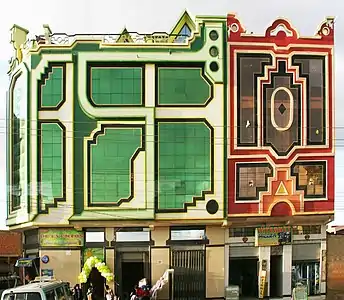Freddy Mamani | |
|---|---|
.png.webp) Mamani in 2015 | |
| Born | Freddy Mamani Silvestre 1 November 1971 Catavi, La Paz, Bolivia |
| Occupation | Architect |
| Practice | Neo-Andean |
Freddy Mamani Silvestre (born 1 November 1971) is a Bolivian self-taught architect[1] noted for his development of the Neo-Andean architectural style.[2] His work is most associated with the city of El Alto and with the new social class of upwardly mobile indigenous Bolivians.
Mamani was born in Catavi[3][4] and received his degrees from the Universidad Mayor de San Andres and Universidad Boliviana de Informática.
Regarding Mamani's architectural style, Italian architect Elisabetta Andreoli, author of "Andean Architecture of Bolivia", once explained that "some of the forms have been taken out of Andean art. The Tiwanacotas used a language of civilization in their forms: textiles, ceramics, and architectural ruins. Mamani uses the Andean cross, the diagonal juxtaposition of the planes, the duplicity, the repetition, the circle, which makes all this a stylisation theme, that is its source."[5]
 Neo-Andean architecture
Neo-Andean architecture
References
- ↑ Valencia, Nicolas (25 November 2017). "Why Freddy Mamani is Leading A New Andean Architecture". ArchDaily. ISSN 0719-8884. Retrieved 19 February 2022.
- ↑ Elisabetta Andreoli (13 July 2015). "'We have money and can build in a way that represents us'". Architectural Review. Retrieved 9 December 2019.
- ↑ Wainwright, Oliver (23 October 2018). "Party palaces and funky funhouses: Freddy Mamani's maverick buildings". The Guardian. ISSN 0261-3077. Retrieved 9 December 2019.
- ↑ "Freddy Mamani's New Andean Architecture adds colour to Bolivian city". Dezeen. 7 February 2019. Retrieved 9 December 2019.
- ↑ Valencia, Nicolas (25 November 2017). "Why Freddy Mamani is Leading A New Andean Architecture". ArchDaily. ISSN 0719-8884. Retrieved 19 February 2022.
Further reading
- La arquitectura de Freddy Mamani Silvestre by Elisabetta Andreoli and Ligia D'Andrea (La Paz: El Alto, 2013)